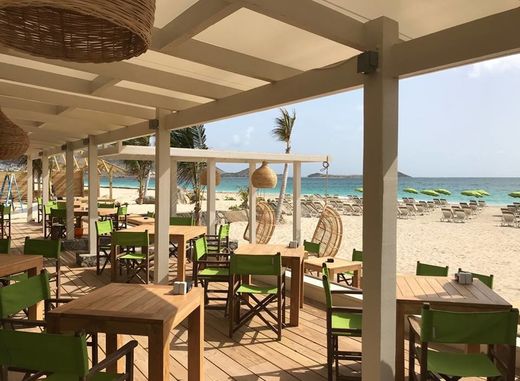ONLINE BOOKING
4 star hotel residence / guest house classification - 97150 Saint-Martin - Antilles / Caribbean

Things to do / see on Sint Maarten “the friendly island”
In the heart of the private park of the Orient Bay in French side
Place of exception, the Adam & Eve Residence is nestled in a green oasis inside the secure park of the Orient Bay. Famous throughout the world, the Saint-Tropez of the Caribbean is characterized by the size and the beauty of its beach. 1.6m (2km) of white sand, water between 25 and 30°C (77 and 86°F) with an extraordinary blue monochrome. At the southern end is the naturist beach of the former Club Orient destroyed by Irma.
Located less than 10 minutes walk from the residence, the village of Orient Bay is a must in Saint Martin. Here, the term “Friendly”, specific to St Martin, takes all its meaning as the atmosphere is so warm and friendly. The “place du village” gathers most of the activities of Orient Bay: bar, restaurant, free concert, craft market on Wednesdays and Fridays evenings… and several local shops.
Supermarket and delicatessen in Orient Bay:
- Petit Casino: Nearby supermarket open every day from 8am to 6pm: Fresh fish and butcher’s shop.
- Le Macaron: French artisan bakery and pastry shop
- On Dirait Le Sud: Delicatessen and artisanal production of fresh pasta
Shops:
- Beachlife Concept: Beach shop – swimwear for men, women and children, light dresses, shorts, flip-flops, beach games for the whole family and buoys of all sizes and shapes for swimming
Theatre:
- Théâtre de la Chapelle : Comedy show
Orient Bay Restaurants
On the beach of Orient Bay you will find:
- Bikini, beach restaurant: fish specialities with exotic flavours
- Kontiki, beach restaurant: modern and refined menu with international influences
- Whai, beach restaurant
- Kakao, beach restaurant
- Coco Beach : beach restaurant
- Playa, beach restaurant
On the naturist beach of Club Orient:
- Small local restaurants
In the village of Orient Bay you will find:
- Télégraphe
- Piment, French cuisine
- SAO Factory, Asian cuisine
- Côté Plages, gourmet French cuisine
- Yellow Sub
- Atelier, meat speciality
- P’tit bistro
- Voile blanche : Traditional French cuisine
- Trattoria : Italian Restaurant
You are an shop of Orient Bay do not hesitate to register on our site via our contact form.
Grand Case Bay
At 10 minutes drive you can enjoy Grand Case, a real typical place with its local restaurants, often called ”la petite France”.
The restaurants of Grand Case:
- Cottage, gourmet restaurant, French cuisine
- Villa Royale, restaurant creole specialties
- Spiga, restaurant Italian specialties
- Rainbow Café, beach restaurant
- Captain Frenchy, beach restaurant
- Ocean 82
- Pressoir, contemporary and seasonal cuisine
- Barranco
- Blue Martini, casual restaurant with musical ambience
Continuing your route you will pass through Marigot, the capital of Saint Martin with its local market, port and shops.
Red bay
Red Bay, the last bend before the Terres Basses and its imposing properties where very famous personalities like to stay.
We find ourselves at the border overlooking a magnificent view of Cupecoy Port at the beginning of the Dutch part, Cupecoy’s tolerated naturist beach.
We leave you the pleasure of discovering the Dutch side with its numerous casinos, jewellery and clothing shops without forgetting the photo shops, computers, tax-free phones etc (Payment in dollars)
You can return to the Adam & Eve Residence via Oyster Pond, a beautiful marina on the border of the French side.
Geographic location
The island of Saint-Martin is divided into 2 parts, Saint-Martin & Sint Maarten: 2 cultures and 2 very different governments without any borders.
The French side and the Dutch side, commonly called French side and dutch side
The area of 93 km2:
- North area French side in overseas community since 1997 54km2
- Southern zone Previously, Sint Maarten belonged to the former “autonomous State” of the Federation of the Netherlands Antilles, within the Kingdom of the Netherlands, but became a State within the same Kingdom on October 10, 2010, following the dissolution of the Netherlands Antilles. 39 km2.
Saint-Martin french side is a very touristy island. Its capital, Marigot, is overlooked by Fort Saint-Louis built in 1776 to protect the island from English attacks
In St Martin we speak French and Dutch as well as English, Spanish, Italian and Portuguese.
The closest neighboring islands are Anguilla and Saint Barthelemy, which emerge from the same underwater plateau located at -40m on average.
There are around ten islets around the island, the largest of which is the very touristy Pinel with its three beaches. We must add Tintamarre Island, located three kilometers from the coast.
The coast of Saint-Martin is divided into numerous bays bordered by around thirty white sand beaches
The communication routes are maritime (commercial port of Philipsburg) and air with Princess Juliana International Airport in the Dutch part and the Esperance Regional Aerodrome (in Grand Case) in the French part.
On the east coast, uninhabited islets (Tintamarre Island, Pinel Island) are surrounded by small fringing coral formations. The sandy bottoms are colonized by vast seagrass beds. While in Saint-Barthélemy, the mangrove cords are reduced to narrow relics, in Saint-Martin, they largely border the shores of coastal lagoons (including Simpson lagoon, fish pond, etc.) and a few bays (Anse Margot , Oyster Pond, etc.)
History of Saint Martin
Christophe Colomb
The island was discovered in 1493 by Christopher Columbus who claimed it for Spain.
Caribbean corsairs and buccaneers enslaved the island’s natives who were often kidnapped from St Martin to work in neighboring islands.
In 1647, the Spanish, deeming the island too small, abandoned it.
In 1648, the island was occupied by only four French and five Dutch. These shared the sovereignty of the island by the Treaty of the Mont des Accords following a running race:
A Dutch runner and a French runner each left at one end to meet. The French having traveled a longer distance, the French zone was endowed with an area larger than the Dutch (approximately 3/5 of the island).
It is said that the French runner, a little drunk, would have taken shortcuts during his race …
And since 1648, the island has been shared between the Dutch and the French, the border between the two parties being just administrative because a free movement agreement between the two areas was included in this convention of 1648.
The French part of the island became a lordship of the Knights of Malta from 1651 to 1665.
This same French part was then attached to St Christophe. French and Dutch had to face incessant English attacks which occupied the whole island from 1690 to 1699.
The island was then completely occupied by France until 1703 when the British occupied the French side. During the Treaty of Utrecht (1713), the Caribbean island of St Christophe was ceded by France to the United Kingdom.
The island St Martin then attached to St Christophe remained isolated for many years, occupied by the English, before being attached by France to Guadeloupe in 1763, (D.O.M).
In a referendum in December 2003, the islanders decided to give St Martin a new status as an overseas collectivity, which took effect in 2007.
Detached from Guadeloupe, the island of Saint-Martin currently at European level in the outermost regions could migrate to an OCT
The economy of the island was successively based on tobacco, indigo tree (the basis of the indigo dye), sugar cane, cotton, salt, livestock. And since the late 1960s, tourism, along with zero-rated shopping, has been the island’s primary economic resource.












